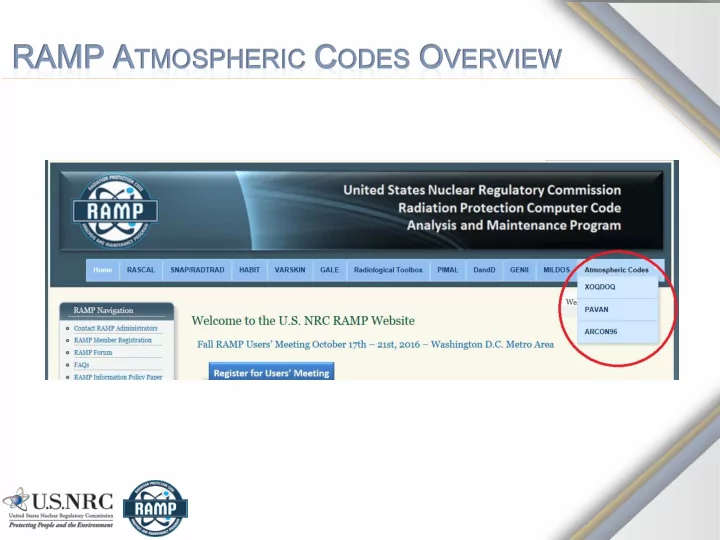

RAMP A P A TM IC C ODE DES O VER TMOSP SPHER ERIC VERVIE IEW
ARCON9 CON96
ARCON9 CON96: O O VER VERVI VIEW EW • ARCON96 is a Gaussian dispersion model for calculating short-term relative concentrations (χ/Q’s ) at nuclear power plant control room air intakes that would be exceeded no more than 5% of the time. • Dispersion is near-field, in the vicinity of buildings. • ARCON96 includes enhanced diffusion coefficients for low wind speed conditions and building wake.
ARCON9 CON96: U U SE SE • Used by the NRC for New Reactor Safety Reviews for design-basis accidents • 10 CFR Part 50, Appendix A, General Design Criterion 19 (GDC 19), Control Room • Adequate radiation protection shall be provided to permit access and occupancy of the control room under accident conditions without personnel receiving radiation exposures in excess of 5 rem (0.05 Sv) whole body, or its equivalent to any part of the body, for the duration of the accident
PAVA PAVAN
PAVA PAVAN: O O VER VERVI VIEW EW • PAVAN is a Gaussian dispersion model for calculating short-term relative concentrations (χ/Q’s ) at offsite locations, including the: • Exclusion Area Boundary (EAB) • Low Population Zone (LPZ) • PAVAN uses Pasquill-Gifford (PG) diffusion coefficients with simple modifications to account for low wind speed conditions and building wake for ground-level releases .
PAVA PAVAN: U U SE SE • Used by the NRC for New Reactor Environmental Impact Statements and Safety Reviews for design-basis accidents • 10 CFR 52.79(a)(1)(vi), Contents of applications; technical information in final safety analysis report • Perform an assessment assuming a fission product release from the core into the containment • An individual located at any point on the boundary of the EAB for any 2-hour period would not receive a dose in excess of 25 rem (0.25 Sv) TEDE • An individual located at any point on the outer boundary of the LPZ would not receive a dose in excess of 25 rem (0.25 Sv) TEDE during the entire period of the passage of the radioactive cloud
XOQD QDOQ OQ
XOQDO DOQ: Q: O O VER VERVI VIEW EW • XOQDOQ is a Gaussian dispersion model for calculating long-term relative concentrations (χ/Q’s ) and deposition ( D/Q’s) at user -specified locations and standard radial distances/segments out to 50 miles • XOQDOQ plume horizontal distribution is assumed to be evenly distributed within the 22.5 degree downwind sector (sector- averaging) • For ground-level releases, plume vertical diffusion coefficient modified to account for building wake
XOQDO DOQ: Q: U U SE SE • Used by the NRC for New Reactor Environmental Impact Statements and Safety Reviews to access impacts from routine releases • 10 CFR Part 20, Subpart D, Radiation Dose Limits for Individual Members of the Public • The annual average concentrations of radioactive material released in gaseous effluents at the boundary of the unrestricted area do not exceed the values specified in Table 2 of Appendix B to Part 20 • Intended to result in doses below 0.05 rem (0.5 mSv) • Appendix I of 10 CFR Part 50, Numerical Guides for Design Objectives and Limiting Conditions for Operation to Meet ALARA Criterion for Radioactive Material in Reactor Effluents • Section II.B: Unrestricted annual air dose < 10 mrad (0.1 mGy) gamma or 20 mrad (0.2 mGy) beta • Section II.C: Unrestricted annual individual organ dose from all pathways of exposure < 15 mrem (0.15 mSv) • Section II.D: radwaste system cost-benefit analysis based on population dose out to 50 miles
• Jeremy Rishel • Mr. Rishel support the RAMP Atmospheric Codes, including ARCON96, PAVAN, and XOQDOQ. In addition, Mr. Rishel supports the development of the NRC’s RASCAL emergency response code. • jeremy.rishel@pnnl.gov • 509-375-6974
Recommend
More recommend